TV Antenna Types: details, comparison, advantages . .
There are many different types of terrestrial television antenna or aerial & knowing which one to choose can be difficult as they all have their own advantages & disadvantages.
TV antennas guides include:
Types of TV antenna
Buying a TV antenna
TV antenna direction alignment & pointing
TV transmitter finder app
TV antenna alignment meter
Buying TV antenna amplifier / booster
Indoor TV antenna & set-up
Satellite TV dish installation
How to wire a TV antenna socket
Why doesn't a TV antenna work any more
General antenna installation guides
Antenna installation guide
Attic installation
Antenna height
There is a huge variety of different types of antenna or aerial used for terrestrial TV and radio reception. The antennas have different shapes and sizes and many look different to the others.
Knowing something of the different types as well as the basic specifications that are associated with them can help when selecting a TV antenna installation.
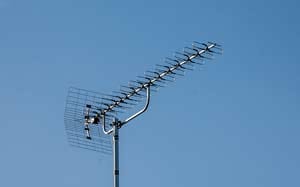
Having a basic understanding of the different types of television antenna (TV aerials), their specifications, and their advantages and disadvantages will enable an informed decision to be made about which is the best type to choose.
It is also worth having an understanding of the various mechanical and environmental aspects of the TV antennas. As they will be in exposed situations to give the best reception, they will receive the full force of the weather and over time this can impact their performance in a variety of ways.
While television can be received from direct broadcast satellites, this page will focus on television aerials or antennas used for ground based or terrestrial television reception.
Basic TV antenna specifications
When looking at television antennas or TV aerials, there are several specifications that are of importance. Most of the specifications will be electrical, but it is also worth cosndiering aspects like the mechanical and environmental issues - from the aspect of how they will stand up to the force of the weather and other similar facts associated wit the environment they are in.
Although the specifications will be given in technical terms, it is often easy to gain a view of the performance, even without a full technical understanding.
By checking the specifications, it is possible to gain a good idea of the performance and balance those factors that may have side effects and cause the operation to be more difficult with those that benefit the operation.
The specifications range from those addressing the electronic or radio performance to those addressing the mechanical aspects of the TV antenna.
Some of the main specifications include those listed below:
Forward gain: The forward gain is the amount of gain in decibels that the antenna exhibits when compared to a reference antenna and expressed in decibels, dB. It should be noted that decibels are based on logarithms and therefore 10dB is an increase in gain of 10 fold, and 20dB is an increase in gain of 100 fold.
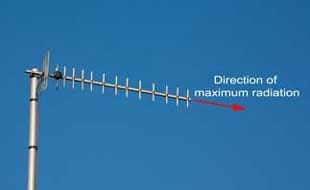
Yagi Uda antenna showing direction of maximum radiation The reference antenna is often a dipole when the gain is referred as x dBd, or an isotropic source when the gain is quoted as x dBi. An isotropic source is a theoretical point source that radiates equally in all directions.
The gain for the television antenna over an isotropic source will be 2.1 dB higher than gain with respect to a dipole.
Polar diagram of a Yagi antenna The level of gain will need to be sufficient to enable a good signal to be received. This may be difficult to judge as signal levels will vary considerably according to the location, distance from the transmitter, height above ground, whether there are any obstructing objects in the way and the like.
Whilst it is possible to consult the transmitter coverage maps in many instances, another good way of assessing what si required is to look at what types of antenna other people are using. It is likely that an antenna with a similar number of elements will provide the required performance.
Beamwidth: As the gain increases so the beamwidth of the antenna decreases. This means that the antenna needs to be more accurately directed towards the transmitter.
High gain narrow beamwidth antennas can be more difficult to accurately orientate towards the transmitter, but they are able to give a better signal to the television.
Antenna alignment meters are more likely to be needed to reap the improved gain of high gain, narrow beamwidth antennas.
Frequency and bandwidth: Antennas are only able to cover a certain frequency range. Outside this range the performance falls and the aspects like the gain, power transfer and the like fall away. As a result it is necessary to ensure that the TV antenna covers the required frequency range.
Be aware that in some countries, and even in different areas of a country television transmissions may be made on widely different frequencies. Normally the transmissions are grouped together in frequency so that the antenna bandwidth can accommodate them all. But check on the Internet or with your local dealer to find out whether antennas need to be bought to match your particular area.
Some countries may have different codes for different sections of the allocated transmission bands.
Although, normally terrestrial TV broadcasts are made on UHF, in some countries VHF may also be used. This will require antennas that can work on both portions of the spectrum. These antennas tend to be a combination of two antennas in one overall TV antenna array.
Read more about . . . . television antennas for different areas.
Dimensions: The dimensions of the antenna can be important in many instances, especially where space may be limited. They may look small in a photo, but when they are seen for real they may be larger than expected. Check the dimensions before buying to make sure it is not too large.
Weight: The weight of the antenna can be an issue in some circumstances. Larger antennas will weigh more and need more robust mounting arrangements.
Windage: One key parameter for any external antenna is the windage - how strong a wind will it tolerate. Antenna types like the multi-boom types tend to present more surface area to the wind and can be more susceptible to the wind.
One of the key elements of a TV aerial or antenna is the reflector. As these present a larger area to the wind, many of these larger reflectors seem to suffer and many have been seen locally with part of the reflector missing. Although having part of the reflector missing may not be noticeable on many installations, if too many parts fall off, not only may they present a danger, but their performance will degrade.
TV antenna types
There are many different types of antenna. many will performance in a very similar way, but they may have slight differences to alter the performance in one way or another, or they may just look a little different.
What ever the antenna, it is necessary to ensure that it performs in the right way for the situation in question. Aspects like the gain, the range of frequency, mechanical aspects and the like all need to be considered.
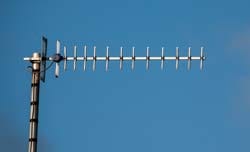
Basic Yagi antenna or aerial for TV applications
The basic Yagi antenna is named after Hidetsugu Yagi, although the person who played the major part in its invention was Shintaro Uda. Accordingly the antenna should more correctly be called a Yagi-Uda antenna.
The basic Yagi is a popular choice for many TV antenna installations and it has a long boom and a number of elements at right angles to the boom: starting at the back there is a reflector. This is often larger than the other elements acting as a large reflecting surface to reflect energy back onto the next element called the driven element. It also serves to reduce the signals in the opposite direction that might cause interference.
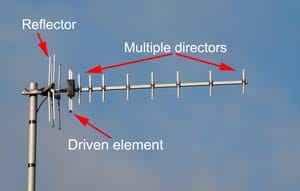
Next is the active or driven element. This is connected directly to the coaxial feeder and it is where the signal is converted from a radio signal (electromagnetic wave) to an electronic signal to be passed along the feeder tot he television set.
In front of the driven element, there are a number of other elements which are called directors. These act to concentrate the beamwidth and give additional gain. There can be a good number of these dependent upon the antenna in question. The more directors, the higher the gain.
Within the basic Yagi antenna, the elements tend to be straight wires or pieces of narrow tube. The reflector can be a straight wire , but in many designs this is much bigger. The driven element is what is called a folder dipole - effectively a straight dipole with the ends connected via a second conductor.
The length of the elements is key to the operation - they should be approximately a half wavelength at the frequency of operation. This means that it is possible to have an idea of the band for which an antenna is used by looking at the element lengths. Ones with short elements like that in the photo are for UHF, and ones with much longer elements are for vHF and so forth.
X type television aerials or antennas
The basic Yagi format can be used with a large number of variations for the director elements and sometimes other elements within the overall television antenna.
As the name implies, these TV antennas or aerials have their main elements in in particular the directors having the form of an X. This format gives a higher level of gain and therefore tends to be used more widely these days.
Bow tie television antennas
A form of antenna using directors that look very similar to a bow tie have also appeared on the market.
These are very similar in concept to the X TV antennas and their performance can be judged according to the specification for the gain, beamwidth and bandwidth.
Although they are fairly widely used, they are a little less common than the X TV antennas.
There are a few other variations on this them with TV antennas sometimes having their directors with a triangle shape instead of the bow tie shape. These are effectively all variations on a similar thee and have the basic Yagi concept as the basis of their operation.
Multiboom Yagi television antennas
Another form of antenna which can provide a very high level of gain is a multi-boom antenna.
As the name suggests, these antennas have a single reflector and driven element, but multiple booms containing directors.
These TV antennas have more than one boom, typically three, angled in slightly different directions.
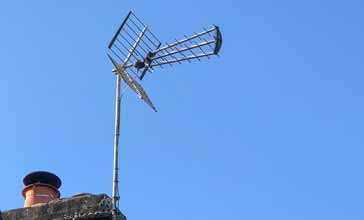
The multiple booms enable the antenna to provide a significantly higher level of gain for a given length, and as a result they can be ideal for some situations.
The downside is that they are much heavier, requiring three booms and as a result, the weight is much greater, and as a result they require much sturdier mountings.
Often these TV antennas are mounted to the mast at the back of the antenna behind the reflector because of the difficulty of mounting to the booms as a result of their angles, although for longer ones this is a necessity.
The additional weight and rear mounting means that they can have a tendency to drop and point downwards after the weather, winds and also birds sitting on them takes its toll. If considering one of these antennas, the initial overall performance and gain can be good, but over time their performance may deteriorate more than others if the mechanical arrangements start to fail.
Log periodic antenna
The log periodic antenna may look a little like a Yagi, but it is actually very different in its construction and operation.
The log periodic antenna has less gain than a Yagi for the same number of elements, but it is able to operate over a much wide bandwidth - often a ratio of 3:1 or 4:1 making it ideal for situations where the television transmissions are widely spaced in frequency.
Unlike the Yagi antenna which as a driven element, reflector and a series of directors, the log periodic consists of a number of elements that act like dipoles. As the elements are larger at the back and smaller at the front, they resonate at different frequencies and with the larger ones towards the back, for any given "active region" on the antenna these will tend to act a bit like a reflector and the smaller ones at the front of the active region will tend to act like a director.
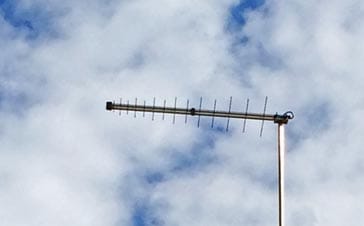
In view of the attributes of the log periodic antenna, they tend to be used in situations where there is a relatively good signal, but the television stations are on frequencies that may be widely spaced.
Other considerations
Apart from the antenna itself, there are other considerations to take into account when selecting a television antenna. Aspects like the fixing and feeder are very important.
Feeder: The feeder or coax is a very important element of the overall television aerial installation. It is no use installing a wonderful aerial, only to have a high loss coax feeder that will attenuate the signal before it arrives at the television. Aways opt for the best, within reason.
It is also very important to ensure that moisture does not enter the coax. If it does, then this will very quickly degrade the performance, increasing the loss significantly. It is always best to seal the external end of the coax as the weather has a habit of finding its way into everything.
Mounting and fixing arrangements: It is important that the antenna is securely mounted. There is a wide variety of fixing systems available for almost every conceivable situation from mounting on the side walls of houses, to chimney fixings and almost everything else.
It is essential that the television antenna is securely mounted using the right fixings and good quality ones. As the television aerial is likely to be in place for many years, it is necessary that it does not fall, with the risk of general safety, even after many years of use.
What is a digital TV antenna
In reality there is no such thing as a digital TV antenna. As far as the antenna is concerned, there is no difference between receiving a digital signal or an analogue signal.
The only issue with receiving a digital TV signal as opposed to an analogue one is that the signal might be on different frequencies. This is where a "digital TV antenna" might be important.
With the wide allocation for television transmissions in some areas of the globe, making sure that the antenna can cover the right band of frequencies is important.
While a digital TV antenna as such does not exist, making sure that the TV antenna can cover the frequencies for digital TV transmissions is important.
There is a vast range of different types of antenna available for television reception. Although many people are now opting for Internet / broadband based deliver of their television content, the use of terrestrial (and satellite) delivery is still very widespread. Selecting a good antenna for the overall TV antenna installation is not always easy, especially with the array of different types. Fortunately the specifications are not particularly complicated and a local television aerial or TV antenna installation specialist will be able to advise what is suitable for the general area and specific situation.
More Antenna & Propagation Topics:
EM waves
Radio propagation
Ionospheric propagation
Ground wave
Meteor scatter
Tropospheric propagation
Antenna basics
Cubical quad
Dipole
Discone
Ferrite rod
Log periodic antenna
Parabolic reflector antenna
Phased array antennas
Vertical antennas
Yagi
Antenna grounding
Installation guidelines
TV antennas
Coax cable
Waveguide
VSWR
Antenna baluns
MIMO
Return to Antennas & Propagation menu . . .



